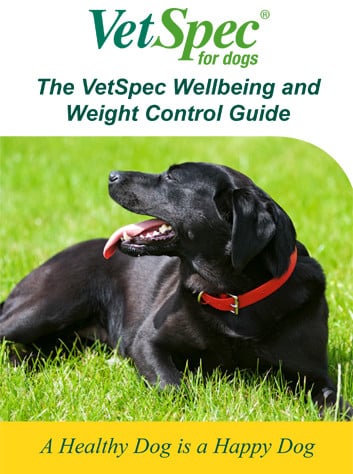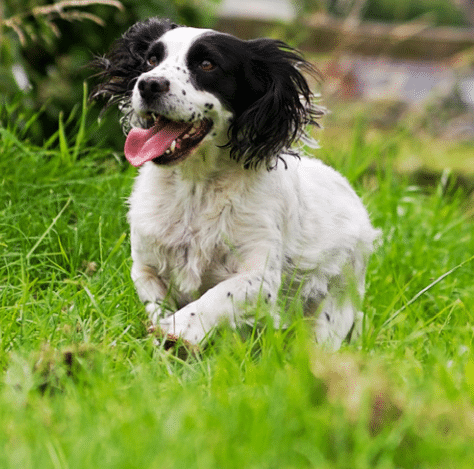
Dear Dog Owner
In today’s busy world, we are always being told to make time for our health and keep an eye on our weight. Well the same can be said for our pet dogs too. The difference being that you, as the owner, must take responsibility for the physical weight of your dog.
Just as we know to be true in humans, the correct bodyweight for a dog significantly reduces the risks of heart disease, diabetes and mobility issues.
This booklet offers you practical tips and advice to help you get your dog to a healthy weight and then maintain that weight, to give your dog the optimum lifestyle for a healthy and lasting life.
We hope you find this information both helpful and supportive as our aim is to encourage you and your dog to have a strong and robust life together. The healthier your dog, the more adventures you can both enjoy over the years to come.
Is my dog overweight?
The very fact that you are reading this booklet means you have taken the first step to considering the weight of your dog as a health factor.
You are probably hoping for a quick reference table to look at some statistics and see where your dog fits. However, very much like humans, your dog is an individual being, and so must have his weight judged as an individual too.
Therefore, you must take a step back and look at the dog’s overall body shape and consider what is actually body fat. You are looking at things not dissimilar to if you were considering your own shape in the mirror. For example, is your dog developing a bit of a paunch? When you look down on your dog, does it have a waist? If you are not sure about this, you are looking for the body tapering slightly after the rib cage. Can you easily feel your dog’s ribs?
If you have answered “No” to any of these questions, you should start to reflect on whether indeed your dog is overweight.
What should I do now if I think my dog is overweight?
The most sensible step to take is to visit your veterinary surgeon. Not only will they be able to check the current health of your dog, but they will advise you on both diet and exercise for him. By consulting a vet he will explain whether your dog has any underlying health issues which may interfere if you increase his exercise programme.
Many vets actually run weight control and weight loss programmes and clinics, providing regular check-ups and the opportunity for you to meet other dog owners taking this serious step for their beloved pet. These clinics will monitor weight loss to ensure the diet is working properly, and very importantly, will make sure your dog is not losing weight too quickly.
What are the health risks for an overweight dog?
As with humans, a dog which carries excess weight will be putting extra strain on its joints and organs. Overloading these creates disease and sadly sometimes premature death.
One of the most common complications of obesity in dogs is diabetes mellitus (sugar diabetes).
Many overweight dogs develop serious joint complications and arthritis can develop too.
Overweight dogs tend to have increased blood pressure. The heart has to work much harder and this can lead to congestive heart failure.
Extra fat in the abdomen pushes against the diaphragm and causes difficulty in breathing.

How do I weigh my dog?
The easiest way to track your dog’s weight is by visiting your veterinary surgeon, who will have the professional equipment for properly weighing him.
However, if you want a go at home, first step on your scales at home. Then step on the scales a second time, whilst holding your dog. The difference between the two weights is how much your dog weighs. This can obviously be quite challenging if you have a big dog. The most important decision is to weigh your dog regularly and do so using the same scales each time.
Do I need to record anything?
It will be an interesting exercise if you record everything your dog eats for a few days before they start a diet. It is quite likely that if you do this honestly, you will notice a pattern of treats emerging, that significantly increase the calorie intake of your dog, to levels above those recommended. Don’t forget to include those treats given by other family members, neighbours, dog sitters and dog walkers.
When your dog is on its diet, it will be useful for you to keep a written log of their food intake, exercise and weekly weight. It can be helpful to plot out the information on a graph. It is always useful to look back on the success story so far, especially if your dog’s weight suddenly reaches a plateau with no real explanation as to why.
It is also good to take plenty of photographs, before you start a weight loss programme, during it and when you have reached your goal. You will be amazed at the journey you have been on.
What sort of diet will my dog need to eat?
The aim is to control the amount of calories your dog is eating each day, just as you would with a human diet. Your vet will happily advise you an appropriate amount of daily calories per day, in order for your dog to reach a target weight. This will take into account his current size, energy level and current health. You can either weigh the food at each mealtime or use a calibrated scoop, but in order to resist any temptation for giving your dog that little bit more, weighing the food will be most effective.
There are no fixed rules as to how often you feed your dog, so you may choose to feed more times with smaller portions, the key to success being not to exceed the daily calories agreed upon. If you are not available at regular times to feed your dog, try a timed automatic feeder. If you are unable to stop giving your dog treats throughout the day, you must either deduct their calories from the overall daily allowance agreed upon or feed them very low calorie snacks, such as apple or carrot.
However, do not give in to whining and crying for more food. Your dog is likely to try this tactic if he knows it will result in him getting more food, which is exactly what you are trying to resist.
Should I increase my dog’s exercise?
Increasing exercise will be helpful, but on its own will not achieve the weight loss you are looking for. You must remember that dogs are naturally very active so to increase their exercise in a way a human would by going to the gym is almost impossible to reach those exercise levels. As with all forms of exercise, you should begin gently and build it up slowly, being especially careful with older dogs and wherever possible seeking veterinary advice first.
A good rule of thumb is to try and take your dog out at least twice a day, and whilst you are out, introduce them to active games rather than leaving them to slowly wander down the street at their own pace. You can then build on this by increasing activity levels when they are back home, by giving them toys that will encourage them to move around more. You should also remember the other benefits of nonfattening exercise; they go a long way towards improving the bond between you both and help you as an owner with your health too.
However, whilst you have taken the important step of increasing your dog’s exercise, you must remain vigilant for signs of fatigue, and rest if you notice signs like heavy panting.
If you simply don’t have the time to give your dog these extra minutes of exercise, hire a dog walker or a teenager who is looking to earn some extra cash. Doggy day care centres are a good choice if your dog will be otherwise spending all day on their own.
What should I do if my dog isn’t losing weight whilst on the diet?
First check that everybody in your household is sticking to the rules, and not sneaking snacks and treats to your dog which will increase its calorie intake. If indeed everybody is sticking to the plan, the diet needs to be reviewed. It would seem as though the dog is still being fed more calories than it actually needs, but you should consult your vet for this advice. Some dogs will simply burn calories more slowly than others, and this may need factoring in to the diet regime.
Could there be an underlying medical reason stopping my dog losing weight?
Just like human beings, dogs can be faced with many health issues, so if a controlled programme of diet and exercise is not having the desired effect, it is likely that an underlying health condition has triggered the weight gain. A veterinary surgeon will be able to take blood samples, to test for low thyroid levels and hormonal imbalances. Overweight dogs can face a large array of health complications, so a failed diet with the correct levels of investigation could actually go on to save your dog’s life.
How long will it take for my dog to reach its target weight?
If your dog looks overweight, it is likely they will weigh at least 15% more than they should do. For the diet to be safe for the overall health of your dog, you will be looking for it to lose about 1% - 1.5% of its bodyweight each week, so significant improvement could take several weeks.
When your dog reaches its target weight, go back to the three questions you asked yourself at the beginning. If you still cannot see your dog’s waist or feel its ribs, and it still looks as though it has a bit of a paunch, there is every likelihood that your dog is still overweight, so you should seek professional advice about a new target weight.
Successful weight loss in dogs is a slow and steady process, and the secret to success is patience.
How will my dog maintain its new healthy weight?
If your dog has reached their healthy target weight, the challenge now is to prevent weight creeping back on again. Therefore, it is advisable to speak to your vet about a weight maintenance programme, which again will be centred around the calories your dog needs to maintain their healthy weight.
Hopefully whilst working towards your dog’s target weight, you have developed some healthier habits as a dog owner. It is now important to stick to these and get the whole family to understand the importance of the overall healthy approach for long term healthy weight management.
Continue weighing your dog as you gradually increase their food intake. If weight is regained consistently for two weeks, you should go back on the diet programme.
Does this regime mean I will never be able to give my dog treats again?
Treats are a useful tool when you are training a dog, but other than for this, they absolutely do not need them. If you really feel the need to treat your dog, you should discipline yourself to give them a treat no bigger than a finger nail. If you are feeding your dog a dry food, when you weigh out a portion, you can always take out a few kibbles and feed them as treats throughout the day. If you are feeding wet foods then raw vegetables like a small piece of carrot are useful alternatives.
Does a diet mean I need to get rid of my dog food puzzle toys?
Puzzle toys are a useful challenge to keep dogs stimulated, as your dog will have to shake or roll the toy to get the food out. However, if you are putting dry dog food inside, you must make sure this is taken off the daily food allowance agreed for your dog. Also, if you have more than one dog, using these toys will make it very difficult for you to keep track of exactly what your dieting dog is eating.
Will a diet affect how much fluid my dog should drink?
Water is as essential for dogs as for human beings. Water makes up 70% of your dog’s body and is essential for circulation, digestion and waste removal.
Dehydration occurs through either reduced water intake or increased fluid loss. Often only a vet can provide a proper diagnosis and treatment for dehydration. So, whilst your dog is dieting, they should still have plenty of clean cold water available for them at all times, as part of their healthy diet.
Are some breeds of dog more prone to obesity than others?
Some breeds of dog are typically slim and probably the most common one is a greyhound. Conversely, some breeds are more prone to obesity. Examples of different sized breeds with a propensity for excess weight are listed below:
Small breeds: Cairn Terriers, Dachshunds and Cavalier King Charles Spaniels
Medium breeds: Beagles, Cocker Spaniels and Basset Hounds
Large breeds: Labradors, Golden Retrievers and Rottweilers Giant breeds: Newfoundlands, Saint Bernards and Bernese Mountain Dogs
However, these dogs can still live long and lasting healthy lifestyles with the correct diet.
How will my other dogs react if one dog is on a diet?
If you have several dogs, feed your overweight dog separately to stop them stealing any leftovers.
Do crash diets work?
You should never starve your dog to try and get them to lose weight quickly. If you believe you are already carefully following advice to feed your dog a recommended daily allowance, reducing their food intake by more than 15% without the right levels of supervision will mean they won’t get the right balance of essential minerals and vitamins, which are vital for a dog’s overall nutrition.
Is there an optimum age to start a dog on a diet?
It is quite likely that a chubby puppy will become a fat adult. You should feed your puppy the minimum amount for the body weight recommended on the packaging, and monitor body shape and weight as your puppy grows. Have a chat with your vet about it when you take your puppy for their vaccinations.
It is important that you do not introduce your puppy to human food as this may then lead them to become a fussy eater as they grow older.
If you get your dog’s diet right from the very beginning, hopefully you should never have to consider a weight loss diet for your dog in later life.
Do any veterinary surgeons specialise in weight loss programmes for dogs?
North Yorkshire based VetSpec have joined forces with a number of veterinary groups around the country to deliver The VetSpec Weight-Loss Programme, a forward-thinking weight management programme for overweight dogs.
The dogs are examined before joining the programme, then key to the overall success of it, the dog must only be fed the food the vet provides. The food is specifically designed for weight loss with a lower concentration of calories than other diet foods currently available.
Owner and dog are expected to return approximately every two weeks for the dog to be weighed and measured. If the rate of weight loss is too high or too low an adjustment will be made to the feeding regime.
The vet will demonstrate your dog’s progress on a graph and indicate how this compares with the other dogs participating in the programme.
What brands of food are recommended for a weight loss programme?
The Veterinary Practices that have joined the programme specifically use food manufactured by North Yorkshire based VetSpec. The food is of a super-premium quality and is designed to be hypo-allergenic with no wheat or gluten content.
Most dogs will be fed VetSpec SuperLite LowCalorie Formula which is ideal for dogs needing to lose weight, greedy dogs that need volume but low calories and less active dogs. VetSpec SuperLite Low-Calorie Formula has all the benefits of the supplements in VetSpec Healthy Dog Adult Formula but is on a base food with 20% less calories if fed as directed. This means that you can control your dog’s weight but still feed a delicious feed, packed with high quality vitamins and minerals, that your dog still needs on a daily basis. VetSpec SuperLite Formula is an outstanding Veterinary Specification supplement in a CEREAL-GRAIN-FREE Super Premium dog food including 50% Chicken with added vegetables and herbs.
VetSpec SuperLite Senior Formula has been developed to take care of all the challenges faced by older dogs. As an adult dog ages, lean body mass declines, resulting in a decrease in total energy needs. The total daily energy needs of an average-sized 7-year-old dog may decrease by as much as 20% when compared with its needs as a young adult. If food intake does not decrease proportionately with decreasing energy needs as the animal ages, weight gain results. Added to this, older dogs tend to be less exercise tolerant and therefore burn less calories for work. They also tend to develop issues with joint mobility particularly if they get over-weight.
